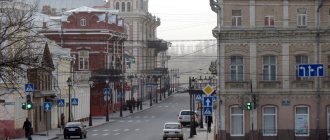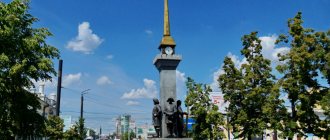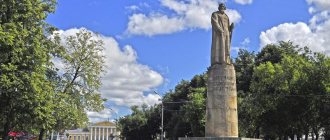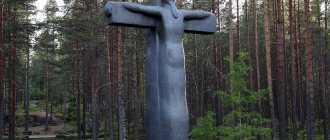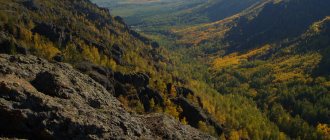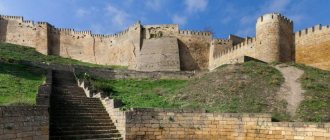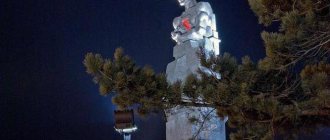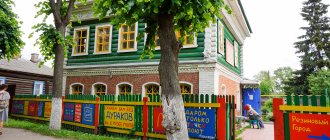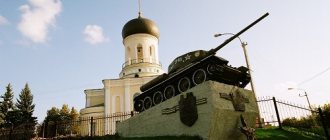Main attractions of Astrakhan
The sights of Astrakhan, photos and descriptions of which you will find in this article, are very diverse. Some of them are considered unique calling cards of the city.
Astrakhan Kremlin
- Address: transport stop "Oktyabrskaya" square.
The perfectly preserved fortress is a wonderful example of Russian fortification art of the 16th century. The citadel, founded under Ivan the Terrible, took more than 25 years to build. It has thick walls, the height of which in some places reaches 8 meters, and 7 powerful towers. The fortress, built on a hill in the middle of the island, still looks impregnable. Now it is a wonderful architectural and museum complex. On its territory there are many historical buildings, the Trinity and Assumption Cathedrals, and several interesting museums.
Monastery of John the Baptist
- Opening hours: daily, from 7:30 to 19:00.
- Telephone.
- Website: https://www.ioanno.ru
- Address: st. Magnitogorskaya, 9. Transport stop “Bolshiye Isady”.
The founding date of the monastery is considered to be 1688, when the authorities gave permission to build a church in a settlement of monks, outside of what was then Astrakhan. Nine years later, a delightful temple with an elegant bell tower was erected here, the main shrine of which was considered the miraculous image of John the Baptist, now lost. Subsequently, several more small churches and buildings were built on the territory of the monastery. After the Revolution, all the property of the monastery was requisitioned, and the novices returned here again in 1995. After the restoration, the monastery looks magnificent.
Opera house building
- Address: st. Henri Barbussa, 16. Transport stop "Opera and Ballet Theatre".
Since its grand opening in 1994, the building that became home to the Astrakhan Opera and Ballet Theater has become an iconic city landmark. The building with an eclectic exterior is not inferior in splendor to palaces. Huge arched windows, elegant turrets, hexagonal domes covered with tiles create a unique architectural composition that you can admire for hours. The aesthetic impression is enhanced by the lush design of the facade. It is decorated with carvings, stucco moldings and other elements of architectural decor.
Astrakhan TV tower
- Address: st. Lyakhova, 4/5. Transport stop "Selenskie Isady".
The fact that the TV tower has become a kind of calling card of Astrakhan is not at all surprising. The elegant structure, erected in 1967, has a height of 180 m, so you can admire it not only from any part of the city, but also from the surrounding villages within a radius of 10 km. The structure, made of high-strength steel, looks especially interesting in the evenings when the lights turn on. By the way, the TV tower is nominated for entry into the Guinness Book of Records as the least energy-intensive structure of this type in the world.
Swan Lake
- Address: st. Admiralteyskaya. Transport stop "Swan Lake".
The unique natural recreation around a fabulously beautiful lake, along the surface of which snow-white swans move gracefully, is not only a favorite vacation spot for city residents, but also an iconic landmark of Astrakhan. Stone stairs descend to the shore of the reservoir. There are alleys and neat lawns laid out around it. There is a delightful rotunda in the center of the lake. She looks so lightweight that she seems to float above the water. It’s simply impossible not to take a stunning memorable photo against the backdrop of this magnificence.
Photo street by Dmitry Dadonkin is honest Astrakhan
AST-NEWS.ru continues to introduce readers to Astrakhan photographers. This time we talked with Dmitry Dadonkin, whose work has its own style. Astrakhan in his photographs is shown simultaneously with subtle irony and a joyful message, regardless of the topic and genre.
– How did photography become not only a hobby, but also a profession?
– I became a photographer three years ago. Before that, he worked as a cook for seven years, although he studied to be a signalman. Gradually, I completely immersed myself in the kitchen, learning to cook almost any dish.
Traveled a lot to other cities. Four years ago he returned to Astrakhan. And then I realized that I didn’t want to cook anymore. Since childhood, I have been interested in art, and when my sister gave me a camera, I decided to try my hand at photography.
I started my practice by filming free events. He photographed everything and everyone.
I was advised to complete some photography courses and become a wedding photographer to earn big money. But instead he went into street photography and reporting.
I like to photograph the everyday life of people on the streets; for me it’s relaxation.
My older colleagues taught me many tricks in photography.
Having gained experience, he began to collaborate with Astrakhan media and make reports. I try to work with federal publications, but they usually say that everything in our city is boring. For example, when I sent a photo report from the celebration of Airborne Forces Day in Astrakhan to the central media, it was not accepted - there were no fights or other disgrace at them.
– Does photography allow you to live comfortably?
- Can. Of course, I don’t get the biggest money. But in addition to my main job, I have additional income. For example, I photograph banquets where you can get five thousand rubles for two hours of work. But after such filming it is difficult to recover.
– Where is the line between commercial photography and art?
– This line was erased for me due to the pandemic, when photographers’ work was reduced and money became scarce. I had to take on any orders.
Sometimes in official and commissioned photographs there are interesting shots, but I cannot publish them so as not to displease the people depicted in them.
– Do you participate in photo competitions?
– Maxim Korotchenko introduced me to photo competitions, for which I am very grateful to him. If it weren't for him, I would never have been involved in such things.
Until I started attending classes at the Platform photo club, which is headed by Maxim, I thought that I had nothing to show. But he convinced me otherwise. So far I haven’t had any big victories in prestigious competitions, but I gradually began to understand the importance of participating in such events. In addition, there are competitions with large prize pools.
– How important is the technical side of the issue in photography? How do you characterize your artistic style?
– In the first year of photography practice, the technical component was important. During the learning process, I wanted to master everything so as not to think about it later. Nowadays I take many street photographs in automatic mode.
Recently one girl told me that she recognizes my photos from all the others, I have my own style. But I don’t feel it myself.
– Have you already exhibited your work somewhere?
– A few years ago, Maxim Korotchenko and Pavel Simakov, I did an exhibition for one day at Bolshiye Isady, on the Yamgurchevsky Bridge. This was a joint event with the Chilim public art festival.
The “Platform” photo club is preparing an exhibition of its participants, which I hope will take place this year. The interaction of photographers within the club is good for competition. Sometimes you sit at home, you don’t want to take a camera and go outside, but then you watch how your colleagues post their new works, motivation arises, and you go shoot.
– How do you feel about the definition of “Astrakhan photographer” and how much did the image of your hometown influence your work?
– I’m not so attached to Astrakhan. As soon as I have the opportunity, I try to travel around the country. Recently I filmed in Sochi, Moscow, Kaliningrad. In our city, I have no ties to any specific places. I just walk around the city and take pictures of everything that I find interesting at a particular moment.
Most often I look for subjects in the Kremlin, on the Volga embankment and in the Brotherhood Garden - it is in these places that I shoot street photographs.
– How important is recognition and success to you?
– It’s nice, of course, when works are praised and singled out from the crowd, but in Astrakhan there is a certain level of recognition that needs to be exceeded. But I’m still stuck in the moment of being recognized by a certain circle of people and for now that’s enough. The process towards professional success develops on its own. I hope that life will unfold in such a way that I will continue to grow in this direction.
– Many creative people in Astrakhan say that it is difficult to get support from relevant departments, so they rely solely on their own strength.
– My friends looked at what kind of support photographers receive in other cities. Against the general background, nothing at all is happening in Astrakhan on this issue. There are regions where there are many platforms and platforms for displaying the work of young photographers who do not need to invest in it.
We are a complete failure with this; everywhere you have to pay yourself. Therefore, when the Platform photo club appeared, it became easier to interact with like-minded photographers. Because showing off your work on social networks is not the same. Live communication with like-minded people is much cooler.
– Do you consider Astrakhan a depressive city?
– I always worked under the slogan “If you want to change the world, change yourself,” but then I realized that this appeal does not work. Astrakhan can really drive you into depression, because there is no active development here. Young people here are bored.
– Do you have any photographic plans?
– I am eager to make a series of photographs about prisoners and shepherds. But agreeing on such filming is not easy. I would like to take a series of photographs about the life of cadets. I tried to film a project with homeless people, in order to draw attention to their problem, but something didn’t work out.
– What quality do you consider most important for a photographer?
- Honesty. For me it is important to convey a certain plot in the moment. If an interesting scene happened and you saw it, but didn’t have time to film it, you don’t need to ask people to repeat the movement or stand the way they were originally. If you didn’t have time, then you didn’t have time. For me, it is unacceptable in street photography to specially adjust a person to a certain light, to tell him what to do. It is also important to notice what others do not see. Or as they say, to see beauty where there is none. These could be interesting details or a funny moment snatched from a boring event.
Ekaterina Nekrasova
History and architecture in detail
Interesting places in Astrakhan will delight you with an abundance of colorful sights. On the streets and squares of the city, tourists will see many historical and architectural monuments.
Tetyushinov's house
- Address: st. Kommunisticheskaya, 26. Transport stop "Oblfoto".
The colorful mansion, erected for the Astrakhan merchant G. Tetyushinov in 1872, is the only monument of wooden architecture of the 19th century preserved in the entire Lower Volga region. At first it was a country residence for the family of a successful businessman, then it was turned into a communal apartment. At the end of the last century, the building fell into disrepair, but after restoration it began to look wonderful again. It delights with the openwork decor of the facade, carved platbands and pilasters. The interiors of the house have also been carefully restored.
Monument to Prince Vladimir
- Address: st. Generala Epishev, 4. Transport stop “Temple of St. Prince Vladimir”.
The monument to the Baptist of Rus' appeared in Astrakhan to celebrate the 455th anniversary of its founding. The idea of erecting a monument that would complete the architectural composition of the Vladimir Cathedral was considered more than once. But, due to the lack of available funds in the city budget, its implementation was postponed. In 2012, Azerbaijan extended a helping hand and took part in financing the project. A year later, the city acquired a new attraction. A bronze sculpture of Prince Vladimir with a holy crucifix in his hand is installed on a pedestal made of Iranian granite. The total height of the monument is 10.5 m.
Wedding Palace building
- Address: Krasnaya embankment, 2. Transport stop "Registrar Office".
The building of the Wedding Palace is considered one of the most colorful architectural sights of Astrakhan. The story of its appearance is as follows. By the middle of the 19th century. the city has become a very significant trade and logistics center of the Volga region. In 1870, local merchants organized an exchange committee. It was housed in a specially built wooden building. However, soon the appearance of the exchange ceased to suit the growing rich businessmen. It was then that a modern mansion with galleries, balustrades and columns was erected, very reminiscent in outline of a merchant steamship sailing along the Volga. After the revolution, it was used for various purposes, and the main Astrakhan registry office was located within the walls of the house in 1964.
Monument to Kurmangazy
- Address: Intersection of Sovetskaya and Kalinina streets. Transport stop "Magazin Kaspiy".
For its 450th anniversary, Astrakhan received a wonderful gift from the government of Kazakhstan. In December 2008, the grand opening of the monument to Kurmangazy Sagyrbaev, an outstanding folk composer and domra player, took place. During his life, he wrote more than 60 musical works, which were included in the golden fund of Kazakh culture, and died in the village of Altynzhar, Astrakhan region. The bronze sculpture depicting Sagyrbaev sitting on a horse with a domra in his hand is installed on a rectangular granite pedestal, the corners of which are decorated with traditional Kazakh ornaments.
Fountain "Petrovsky"
- Address: Petrovskaya embankment. Transport stop "Oktyabrskaya Square".
There are a lot of fountains in the city. Each of them is interesting in its own way, but the one located in the recreation area between Gorky Street and Petrovskaya Embankment is especially popular among citizens and tourists. The main nozzles, spewing powerful jets of water, are installed in the central part of the granite bowl. Around it there are several more concentric circles of geysers. Every hour the water jets begin to dance, changing levels. Moreover, their height either increases or decreases to the beat of the musical composition. The main show begins at dusk, when the colorful lighting also turns on.
Photos of Astrakhan in the past and present. To the 300th anniversary of the Astrakhan province. Part 3
On the occasion of the 300th anniversary of the Astrakhan province,
Point-A continues to introduce its readers to photographs of old Astrakhan from the photo project of the Head of the State Public Institution of JSC "Astrakhan Regional Resource Center" Vadim Mankov.
The photo shows the building at Chalabyan, 16. In 1946 (at the time of photography) the club of the Stalingrad Suvorov Military School was located here. The school itself was located in Astrakhan from 1943 to 1946. The main building was located at Chalabyan, 17. The official opening of the school took place in December 1943, 612 Suvorov students sat down at their desks.
Last year and in the second half of the 90s.
May 1, 2021 and November 7, 1961
Zvezdnaya Street last year and in the first half of the 80s.
2017 and 1949 The photo from the Volga newspaper shows the entrance to the port territory - the central arch of the 17th pier on what is now Admiralteyskaya Street.
2017 and August 1949. The photo from the Volga newspaper shows the launch of models of warships by young shipbuilders of the Palace of Pioneers. The newspaper wrote: “Last Sunday, unusual flotillas appeared on the May Day Canal. Models of various rubber-powered warships glided across the water. Then small ships with white sails came out onto the water. Numerous spectators who filled the banks of the canal watched with interest the progress of self-propelled floating models. On that day, the first regional competitions in marine modeling were held in Astrakhan. Adult and young shipbuilders submitted more than two dozen models of warships, tugboats and sailing vessels to the competition.”
The intersection of Admiralteyskaya and Nikolskaya now and in the first post-war years. In a large three-story building - the V.I. Hotel. Smirnova (built at the turn of the 19th-20th centuries). The building housed 60 rooms and a restaurant. During the January battles of 1918, the hotel was badly damaged by fire and at the end of the 20s it was almost completely dismantled during the formation of a wide and straight street along the Kremlin wall (now it is Admiralteyskaya). And now we see only a small surviving part of the former hotel building. There are rails in the foreground. Until the mid-50s there was a turning tram ring here.
The intersection of Esplanadnaya and Kommunisticheskaya streets. The tower and abbot's building of the former Spaso-Preobrazhensky Monastery at the beginning of the 20th century (the monastery itself was no longer active by that time).
The intersection of Esplanadnaya and Kommunisticheskaya streets (now and in the 80s). The well-known stop “Tower” and the corner tower of the fence of the former Spaso-Preobrazhensky Monastery (now there is an icon shop).
The intersection of Esplanadnaya and Kommunisticheskaya streets, but only now in 2021 and 1983.
The intersection of Esplanadnaya and Kommunisticheskaya streets now and in the first post-war years. The photo clearly shows the city estate of the Kononovs, built at the end of the 19th century. Further down the street is the red house of E.G. Bukhartseva. It also appeared at the end of the century before last. Both houses are included in the list of architectural monuments.
A section of Kirov Street along the Bratsky Garden last autumn and in the first post-war years.
ACCC now and around 1970. In the foreground on the left is the abandoned pit of an unbuilt swimming pool. Behind him is a “view from the back” of the ACCCC House of Culture. Now here is the cultural center of ASU. Behind the cultural center you can see the buildings of a cardboard and paper workshop. To the right is a three-story building (in the old photograph) - the plant's headquarters. Later it was added to the 1st floor (the green building in the modern photograph). Now here is the administrative building of the Severnaya Thermal Power Plant. Behind this building (in the old photo) is a tall structure and a huge chimney. This is a soda recovery boiler designed to regenerate chemicals used in the production of pulp using the sulfate method with heat recovery to produce steam for energy parameters. That is, the heat from burning the lye was additionally used for production needs and heating the village. And the missing amount was generated by a thermal power plant. Since paper is no longer boiled here, the building along with the pipe was dismantled. In a modern photograph we see the new pipe of the Severnaya CHPP. On the right, towards us, is Mosin Street. The photographs were taken from the side of Bumazhnikov Avenue.
The former tram stop at the intersection of Sverdlova and Admiralteyskaya streets last summer and in the first half of the 80s.
Church in honor of the Holy Equal-to-the-Apostles Prince Vladimir last fall and in the 1950s. The temple was consecrated in July 1902. Closed in 1939. After closing it was used as a warehouse. At the end of the 1960s, a bus station was opened in the temple building. In July 1999, the bus station was moved to the old railway station building, and the temple was returned to the Russian Orthodox Church.
The intersection of Sovetskaya and Kommunisticheskaya streets, a festive demonstration on March 8, 1923.
Three pseudo-panoramas of the Astrakhan Kremlin. The top row is made up of two photographs from 2015; the middle one is from two photographs from 1979; the bottom one is from photographs taken in 1894.
Persian mosque on the street. Kirov before the revolution and now. The minarets were dismantled when the mosque was converted into a sewing workshop in 1939.
The area of the stadium and Latyshev Street (until 1957 - Boldinskoe Highway) now and in 1943. On the left is the city water intake that moved here before the war. Then there is a vacant lot where a stadium will appear in 1955. Then along Pryamaya Bolda there is a large territory of a cooperage factory. He first bore the name of Stalin, then Kalinin. Now here is the Astrakhan “Santa Barbara” - a small cottage community. Then, refrigerator buildings are visible on both sides of the railway bridge. And further to the right of the bridge is a fish factory.
Theater Park now and Leninsky Park in 1943.
Photo from the Prechistenskaya bell tower of the Kremlin. Much has changed in the decade separating the photographs.
To be continued.
Previous materials:
Mentions of Astrakhan: enthusiastic and not so... Mentions of Astrakhan: enthusiastic and not so... Part 2 Taras Shevchenko. “Oh yes Astrakhan! Oh yes, the port is a city. You won’t find fish soup” “Spoil the City”: Astrakhan through the eyes of Ivan Aksakov. Part 1 “Spoil the city”: Astrakhan through the eyes of Ivan Aksakov. Part 2 Nemirovich-Danchenko. Along the Volga: essays and impressions of a summer trip. Part 1 Nemirovich-Danchenko. Along the Volga: essays and impressions of a summer trip. Part 2 Nemirovich-Danchenko. Along the Volga: essays and impressions of a summer trip. Part 3 Nemirovich-Danchenko. Along the Volga: essays and impressions of a summer trip. Part 4 Artists brothers Chernetsov. Astrakhan II half of the 19th century Astrakhan province of the 19th century. on unique photographs by S. Vishnevsky Vintage photographs of S.I. Klimashevskaya. The first Astrakhan tram The first postcards with views of the Astrakhan region V.A. Sergeeva. The end of the 19th century in the Golden Fund of Astrakhan photography. Mikhail Alekseevich Kozlov Photos of Astrakhan in the past and present. To the 300th anniversary of the Astrakhan province Photos of Astrakhan in the past and present. To the 300th anniversary of the Astrakhan province. Part 2
Astrakhan churches, cathedrals, temples and mosques
Astrakhan is inhabited by people of more than 100 nationalities belonging to 14 faiths. Moreover, every nation has the right to profess its own religion. Therefore, there are quite a lot of temples in the city. The churches and mosques of Astrakhan, built at different times, are not inferior in beauty to the religious buildings of Tula or Vladikavkaz.
Assumption Cathedral
- Working hours: Monday to Friday, from 9:00 to 17:00.
- Telephone.
- Website: https://www.astrsobor.ru
- Address: st. Trediakovskogo, 2. Transport stop “Trediakovskogo Street”.
The five-domed white stone church, which is the dominant feature of the Kremlin complex, is considered by experts to be perhaps the best example of Russian religious architecture of the early 18th century. It was erected over 11 years, and in 1710 it was consecrated. The construction work was supervised by a wonderful serf master, Dorofei Myakishev. The facade of the cathedral is decorated in the Moscow Baroque style, popular at that time in Rus'. Another architectural feature makes the building unique. The place of execution, to which a wide staircase leads, is attached directly to the foundation of the cathedral. No other temple with a similar exterior has survived in Russia.
White Mosque
- Opening hours: daily, from 8:00 to 18:00.
- Telephone.
- Address: st. Zoya Kosmodemyanskaya, 41. Transport stop “Fishery College”.
Among the Muslims who inhabited Astrakhan at the beginning of the 19th century, there were many wealthy merchants. With the money of one of them, a white stone mosque was erected in 1810, instead of a wooden structure that had burned down earlier. The building with the blue dome turned out to be very elegant. A tall minaret with an elegant balcony surrounded by a balustrade was built next to it. After the revolution, the wonderful tower was destroyed. The mosque was converted first into a kindergarten, then into a bakery, and then its premises housed the workshops of a plywood factory. The temple was returned to believers in 1992. After restoration, which lasted almost 8 years, the oldest mosque in Astrakhan looks amazing again.
St. Vladimir's Cathedral
- Address: st. Generala Epishev, 4. Transport stop “Temple of St. Prince Vladimir”.
A delightful temple with blue carved domes delights with the eclecticism of its exterior, characteristic of Russian religious architecture at the turn of the 19th and 20th centuries. There is a lot of Byzantine, Moscow and even European in its surroundings. In addition to its external originality, the cathedral is also interesting for its history. At first it performed a missionary function, since it was located on the border of the Tatar and Russian settlements. In the 30s of the last century, the temple was almost taken over by renovationists, and then it was converted into a bus station. The re-consecration ceremony of the cathedral was held in 2001 after restoration work was completed.
Kirillovskaya Chapel
- Address: st. Trediakovsky, 2/19. Transport stop "Oktyabrskaya Square".
The building with an unusual exterior is considered, at the same time, an architectural monument and a religious building. A small chapel was erected in 1677 over the resting place of Abbot Kirill, who for many years was the abbot of the Trinity Monastery. It acquired its unusual exterior almost two hundred years later. Then an antique portico was added to the elegant building in the original Russian Empire style, supported by four columns of the Doric order. The authorities considered that with its architecture the chapel would introduce dissonance into the Kremlin ensemble, which was built up with classical buildings. After the revolution, the building was used as a warehouse, and was returned to the church in 1992.
Photos of Astrakhan in the past and present. To the 300th anniversary of the Astrakhan province. Part 2
On the occasion of the 300th anniversary of the Astrakhan province,
Point-A continues to introduce its readers to photographs of old Astrakhan from the photo project of the Head of the State Public Institution of JSC "Astrakhan Regional Resource Center" Vadim Mankov.
Komsomolskaya embankment in 2021 and 1977 On the left is the floating restaurant “Rybak”, on the right is the pier for the water buses “Stadium”.
The Volga and Kutum Spit now and in the first post-war years.
Cafe on Swan Lake, 60s.
Just recently... And now...
Zhelyabova Street in 1960. Behind the Crimean Tower of the Kremlin you can see a piece of the reconstructed Red Gate tower. It is noticeable that the new tower has not yet been painted and the hip roof has not been made.
Pre-war photograph of the future Swan Lake.
Swan Lake the fall before last and in the second half of the 50s.
These two photographs of Lenin Square are separated by exactly 57 years. One photo was taken on July 24, 2021, the other on July 24, 1960.
The monument to Alexander II in the Governor's Garden before the revolution and the monument at the mass grave in the Brotherhood Garden now. And although both monuments stand on almost the same pedestal, the installation locations are different. The Emperor “stood” somewhat closer to the Museum of Military Glory (about 10 meters) and “looked” in the other direction.
In the top photo: in the large hall of the residence of the governor of the Astrakhan region, on March 5, 2015, a plenum of the regional veterans’ organization and the solemn presentation of the anniversary medal “70 years of Victory in the Great Patriotic War of 1941-1945” are being held. In the bottom photo: in the same hall there is a meeting of the Knights of St. George on October 7, 1916.
Darwin Street (at the intersection with Baku) with a difference of 100 years. The photo shows a group of prisoners of war at the construction of a sewerage system. In 1915, an attempt was made to build the first Astrakhan sewer system. Hundreds of prisoners of war worked on its construction. But the protracted First World War and subsequent revolutionary events did not allow the construction to be successfully completed. The next time an attempt was made was in the 1930s. Many prisoners of war also worked on the modernization of the city power plant. Prisoners were regularly brought in to work on strengthening coastal embankments, constructing new and repairing old pavements, and servicing the sewage convoy (removal of sewage). Prisoners were also recruited en masse for agricultural work.
The main house of the Weiner family estate on the street. Baer with a difference of 100 years. The house was originally two-story with a mezzanine. Already in Soviet times, a third floor was added. The Weiner family of industrialists owned mainly breweries in Astrakhan class=”aligncenter” width=”353″ height=”533″[/img] A photograph of the late 19th century was taken along Akhmatovskaya Street. In the foreground is the Shaposhnikov house (built in the 60s of the 19th century). In the old photograph the house is two-story, in the new one it is three-story; after the war the house was built on. The building of the Military Administration of the Astrakhan Cossack Army has not yet been built (now the Museum of Military Glory).
Exactly 117 years ago - June 24, 1900 - the first trams appeared on the streets of Astrakhan. Traffic was opened along 4 routes at once. A total of 9.25 km of track were built, which were served by 15 motor cars.
Sretenskaya Church before the revolution and St. John the Baptist Church now.
The territory of the St. John the Baptist Monastery before the revolution and now. An old photograph shows all three monastery churches. On the right is the Sretensky Church (now called St. John the Baptist), the dome of the St. John the Baptist Monastery Cathedral peeks out from behind it. On the left was the bell tower with the Church of St. John the Warrior. The last two churches were demolished in the late 20s. The surviving Sretensky Church was closed in the early 30s. And then the church premises were used as a warehouse. In 1989, the former Sretensky Church was returned to the Russian Orthodox Church (and after that it was renamed St. John the Baptist). In the foreground is the rector's building with a turret topped with a trumpeting angel.
The pre-revolutionary photograph shows the goods pier of the Caucasus and Mercury society. On the shore you can see the chimneys of a former state-owned mechanical plant. To the right was the passenger pier of the same society (we now call this area “pier 17”). Previously, there was a military seaport here, which was transferred from Astrakhan to Baku. By imperial decree, the port property was transferred to the Caucasus and Mercury society. The Caucasus and Mercury Society is one of the three largest Russian pre-revolutionary shipping companies on the Volga and Caspian Sea. Carried out passenger and cargo transportation along the Volga, its tributaries and the Caspian Sea. It was formed in the mid-19th century, and after the revolution it was nationalized.
View from the Prechistenskaya bell tower of the Kremlin, 2021 and the mid-70s of the last century.
The top photo shows Sabantuy 2017 at the central stadium. At the bottom there is a festive event for the 60th anniversary of the pioneer organization in 1982.
View from the Kremlin bell tower towards Nikolskaya Street. Last year and at the end of the 19th century. In the foreground is the building of a children's music school. Previously, it was a house for the apartments of the senior cathedral clergy.
Lenin Square now and in the second half of the 70s.
To be continued.
Previous materials:
Mentions of Astrakhan: enthusiastic and not so... Mentions of Astrakhan: enthusiastic and not so... Part 2 Taras Shevchenko. “Oh yes Astrakhan! Oh yes, the port is a city. You won’t find fish soup” “Spoil the City”: Astrakhan through the eyes of Ivan Aksakov. Part 1 “Spoil the city”: Astrakhan through the eyes of Ivan Aksakov. Part 2 Nemirovich-Danchenko. Along the Volga: essays and impressions of a summer trip. Part 1 Nemirovich-Danchenko. Along the Volga: essays and impressions of a summer trip. Part 2 Nemirovich-Danchenko. Along the Volga: essays and impressions of a summer trip. Part 3 Nemirovich-Danchenko. Along the Volga: essays and impressions of a summer trip. Part 4 Artists brothers Chernetsov. Astrakhan II half of the 19th century Astrakhan province of the 19th century. on unique photographs by S. Vishnevsky Vintage photographs of S.I. Klimashevskaya. The first Astrakhan tram The first postcards with views of the Astrakhan region V.A. Sergeeva. The end of the 19th century in the Golden Fund of Astrakhan photography. Mikhail Alekseevich Kozlov Photos of Astrakhan in the past and present. To the 300th anniversary of the Astrakhan province
Cultural leisure of tourists in the city
The colorful city is not only an important economic center of the Volga region. It lives a rich cultural life, which it invites its guests to join. Here are just a few places you should definitely visit in Astrakhan.
Museum of Local Lore
- Opening hours: daily except Monday from 10:00 to 17:00, Friday and Saturday from 10:00 to 19:00.
- Ticket price: adult 300 rub., reduced price 180 rub., child 120 rub.
- Telephone.
- Website: https://www.astrakhan-musei.ru
- Address: st. Sovetskaya, 15/5. Transport stop "Museum of Local Lore".
With 14 branches, the institution is considered one of the largest provincial museums in Russia. Its collection includes over 300 thousand exhibits telling about the nature, history, ethnography of the Volga region, and the original culture of the peoples who have long inhabited these lands. The pride of the museum is considered to be the unique collections of medieval edged weapons and exquisitely crafted jewelry, shown in the “Gold of the Nomads” exhibition.
House-Museum of B.M. Kustodieva
- Opening hours: daily, except Monday, from 10:00 to 18:00, on Thursday from 13:00 to 21:00.
- Ticket price: adult 60 rubles, children 40 rubles.
- Telephone.
- Website: https://www.ast-kustodiev.ru
- Address: st. Kalina, 26. Transport stop “Council of Trade Unions”.
An excursion to the museum dedicated to the life and work of the famous Russian artist B. Kustodiev will bring a lot of vivid impressions to art lovers. To be fair, it should be said that the painter himself, who left for St. Petersburg at the age of 18, did not live in the mansion where the exhibitions are located. However, he had been here more than once to visit his godmother. In addition to Kustodiev’s beautiful paintings, visitors will be able to see a collection of things that surrounded him during his life, and visit the hall, the surroundings of which replicate the interior of the artist’s studio.
Drama Theater
- Opening hours: performances are given from Wednesday to Sunday inclusive. Performances start at 18:00.
- Ticket price: from 200 rub. up to 600 rub.
- Telephone.
- Website: https://www.astradram.ru
- Address: st. Sovetskaya, 28. Transport stop "Dramater".
It’s simply impossible not to attend one of the performances of the Astrakhan Drama Theatre. It was founded back in 1810. After 79 years, the troupe moved to an elegant mansion, which is considered a historical monument. M. Ermolova and V. Komissarzhevskaya once shone on the theater stage. His stage revealed the talent of O. Strizhenov and the inimitable L. Chursina to Russia. V. Menshov began his creative career here. Today the theater's repertoire includes plays of various genres based on modern and classical playwrights.
Where to go with children in Astrakhan
In hospitable Astrakhan, which warmly welcomes tourists, not only adults, but also young travelers are welcome. The city has prepared a wonderful entertainment program for children.
Planetarium
- Opening hours: daily, except Monday. On weekends from 9:00 to 19:00, on weekdays from 9:00 to 17:00.
- Ticket price: adult 250 rubles, children 120 rubles.
- Phone: +7 851 226‑25-76.
- Address: st. Admiralteyskaya, 1/8. Transport stop "Swan Lake".
The city planetarium, established in 1959, is located in a luxurious building built in the middle of the last century, with amazing architectural elegance. It is equipped with the most modern equipment that allows you to create unique effects during a virtual journey through distant galaxies. In addition to the main program, visitors are invited to view an interesting exhibition dedicated to the development of astronautics and admire a wonderful collection of models of rockets, satellites, and airplanes.
Circus
- Working hours: from Wednesday to Sunday inclusive. Performances start on weekends at 16:00, on weekdays at 18:00.
- Ticket prices: from 500 rubles to 1200 rubles.
- Phone: +7 851 251‑14-92.
- Website: https://www.circus-astrahan.ru
- Address: st. Kakhovskogo, 1A. Transport stop "Circus".
There is a special attitude towards the circus in Astrakhan. It is no coincidence that since the middle of the 19th century. century, up to four tents operated here simultaneously, and already in 1898 a building was built for performances by acrobats, jugglers, and magicians, capable of accommodating 1,200 spectators. Circus performances are no less popular today, often attracting full houses. The most famous troupes consider it an honor to perform in the Astrakhan circus; they triumphantly tour different countries of the world. Be sure to take your child to a colorful show performed by wonderful artists.
Park "Planet"
- Opening hours: daily from 10:00 to 23:00.
- Ticket prices: you can ride the attractions by paying from 60 rubles. up to 150 rub.
- Address: intersection of Zvezdnaya and Ostrovsky streets. Transport stop "Park Planet".
The largest entertainment recreation center in the city is exactly the place where a child of any age can have a wonderful rest and gain vivid emotions. There are many attractions here, there are two small ponds on the water surface of which they offer catamaran rides. Those interested are invited to come into contact with wildlife at the petting zoo. For the youngest visitors there is a playground with swings and other safe attractions. Experienced animators conduct colorful performances for kids.

